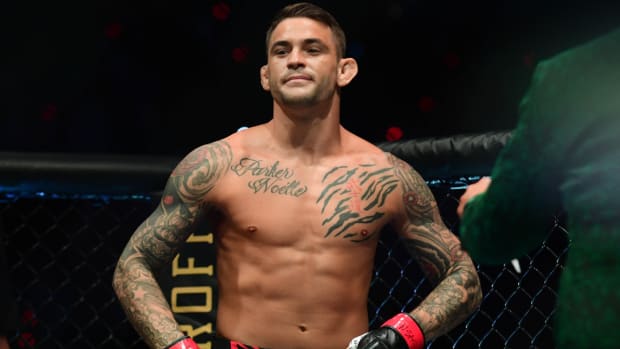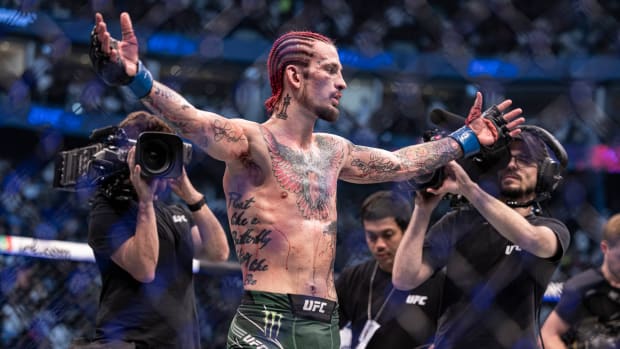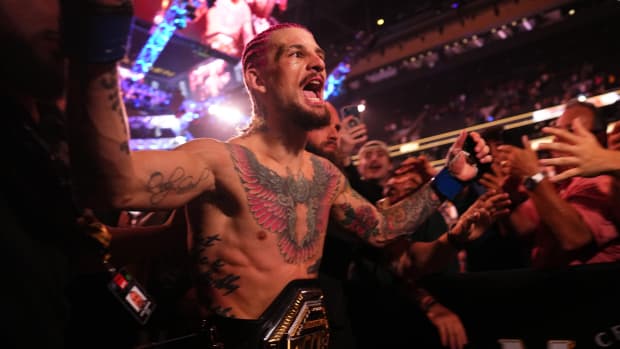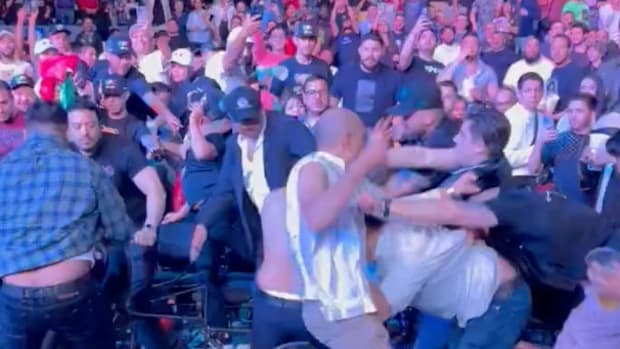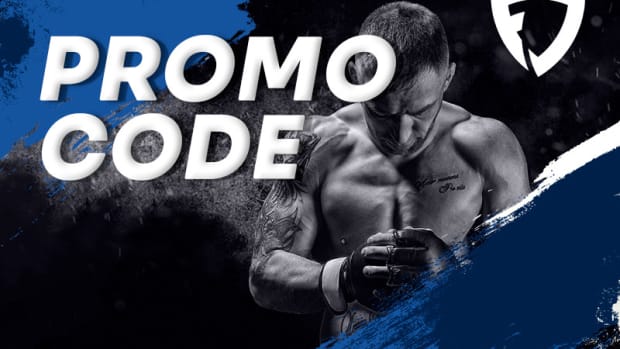'Goyito' Perez representing Mexican heritage at UFC 155
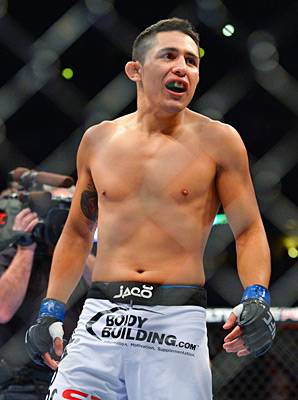
Erik Perez is the UFC's only Mexican-born fighter and the link to the country's fans.
Ron Chenoy/US Presswire
ALBUQUERQUE -- Not even the most prescient UFC observers can say for sure which of next week's UFC 155 fights will feature the most entertaining ending but this much is certain: We already which one will have the most captivating beginning.
The lights of the MGM Grand Garden Arena will dim. The fighter's curtain will pull back and a masked man will emerge, obscured by the red, white, and green and eagle's feathers of the Mexican flag. Then the horns of the mariachis will blare, trumpeting not only the emergence of a fighter but of a bloodied country's momentary relief and of an ascendant league's international aspirations. At that moment, UFC bantamweight Erik "Goyito" Perez will fight.
Honoring his Aztec forbearers who believed they derived strength by wearing máscaras, or masks, Perez's entrance is as much about theatrics and heritage as it is about business and bottom lines. In the UFC's stable of roughly 400 fighters, Perez is the league's only Mexican-born fighter and it's most promising entry point into Mexico's 112-million person marketplace. UFC president Dana White has been forthright about "aggressively" cultivating the Mexican market and says he's at work on introducing The Ultimate Fighter: Mexico series. And for good reason. The boxing-loving country bolsters Pay-Per-View and cable ratings -- the sports' economic lifeblood -- when the card features a fellow Mexicano. Take, for example, the 1.05 million PPV buys for this month's Manny Pacquiao bout against Mexican Juan Manuel Marquez compared with the 900,000 buys for Pacquiao's June match-up with American Tim Bradley.
But the inclusion of Perez's bout against Byron Bloodworth (6-2-0) is less about globalization as it is about competition. Perez boasts a 2-0 UFC record, 12-4-0 overall, and aggressive, Mexican-boxer fighting style. Last August, he knocked out Ken Stone in an astounding 17 seconds, a bantamweight record. Making each of his victories even more impressive? Perez accepted each UFC fight on short notice. The Bloodworth fight marks his first UFC appearance with a full camp under, what he hopes, is his future belt.
"If the UFC says, 'tomorrow you're fighting,' I'm going to fight," says Perez, 23, relaxing on a couch in Greg Jackson's office last week after a morning wrestling workout at Albuquerque's Jackson-Winklejohn Mixed Martial Arts and an afternoon swim.
That's not just fighter's bluster but a track record. As a 16-year-old Sanda master in his native Monterrey, he was working out at the gym one Friday morning when the phone rang. A promoter from the Veterans of the MMA event taking place the next day at the city's arena waited on the other line, asking Perez if he's be interested in a professional fight ... the next day. "Come weigh-in right now," the caller instructed. The teenager who'd already earned the nickname "Goyito" -- the young one -- tipped the scales at 145-pounds on Friday and stepped in against a bearded, bigger and older opponent from Pennsylvania on Saturday. "Everyone was surprised I was going to fight this chavo," says Perez, who recalls exchanging two punches with the American before capturing the man in an armbar. When the referee raised Perez's hand in victory, Perez said, "This is what I want to do for the rest of my life."
It's because of fighting, in a sense, that Perez may have a rest of his life, at all. Growing up Guadalupe, a working-class section of the otherwise wealthy Monterrey, Perez obsessed over the taekwondo triumphs of his favorite lucha libre fighter, fortuitously named, of all things, Octagon. But Perez's own fights took place far away from rings or arenas or structure. He brawled at home with his four brothers and in the streets with his neighbors.
"I had mean in my blood," Perez says. "The neighborhood where I'm from, if you were the strongest, nobody was going to bother you. If you weren't, they were always going to pick on you. As a kid, I always had to break out of my caste and show I was the strongest."
That show of strength earned him four school expulsions -- two in primary school, two in secondary. His parents, Azucena, a storeowner, and Gregorio, an iron wholesaler, tired of his energy and decided to channel it, enrolling him in Sanda, the Japanese boxing discipline. He studied under coach Daniel Benavidez and soon excelled at everything from Sanda to muy thai. His talents soon had him traveling to the US-Mexico border to work with prominent striking coach Mike Valle in Texas. It was through Valle that Perez met Jackson at a training seminar in Mexico.
Another fighter in Jackson's stable, Julie Kedzie, remembers Jackson's team being taken with "the smiley guy over there," she says. But it wasn't so much Perez's perpetual smile but powerful kicking that earned him a one-month invitation with Valle to work out at Jackson-Winklejohn's with perhaps the deepest roster of fighters anywhere.
On a cold February day in 2007, an 18-year-old Perez traveled from Guadalupe to Albuquerque. "It was really hard," Perez says of the move. "I came here not knowing any English, to a state I didn't know, to live with people I didn't know." He had nothing more than $100 in his pocket and determination in his soul. More than 900 miles from home, he was now one step closer to proving to all those who had told him time and again that no Mexicans would ever make to the UFC. The kid who used to blow off English class in high school, saying he'd "never be in the United States" now took instruction from coaches Greg Jackson and Mike Winkeljohn in that language he once swore he'd never need, learning the language of fighting and English all at once. His teammates first mocked, then corrected him as Perez attempted to execute his English, proudly proclaiming to everyone he met, "Me training. Me training."
But if life was hard for Perez in Albuquerque, it would have been brutal in Monterrey. Not long after his departure, his friends and family found themselves in the crosshairs of Mexico's bloody drug war. Roughly 60,000 of his countrymen have been killed since Perez's exodus. In August 2011, gunmen stormed an iconic Monterrey casino, killing 52 people.
Neither Perez, nor his family or friends, have been sparred. His brothers have been robbed, friends killed, and two years ago, Benavidez -- his first coach -- kidnapped. He hasn't been heard from since. Perez's friend whom he employed to help manage his Facebook pages, too, is now gone, jailed on allegations of drug distribution that Perez swears are bogus. He believes the incarceration links to his friend's downloading of anti-government songs rather than any criminal activity. "It's very hard there right now," he says, letting out a more quite version of the grunt he lets out when he hits mitts. "It makes me mad but I have to keep moving forward."
His next step forward, at least professionally, will be on his biggest stage to date. Bloodworth will try for the takedown, Perez surmises, in an attempt to neutralize the Mexican's record-setting striking. But Valle says Perez's fighting has improved all around.
"I'm not the fighter I was a year ago or six months ago," says Perez. "I've improved a lot."
Perez knows he's not just fighting to beat Bloodworth but to represent his country -- and then convert it into a UFC hotbed. "I have to win because I'm the only Mexican in the UFC. It's the same pressure I use to train constantly." Valle notes that the boxing-savvy country's reticence to MMA stems from entrenched machismo, making people uncomfortable at seeing two men rolling around together as they grapple.
In the hierarchy of Mexican loyalties, however, devotion to boxing succumbs to love of countryman. Perez is banking on it. "I've got the blood of an Aztec warrior, of a Mexican warrior," he says. "When it's time to fight, I'm going to fight ... I want to fight to show that there are good things that come out of Mexico, not just bad things. That all things are possible with hard work and determination. I fight to show that."
And the UFC hopes that there's an audience on both sides of the border that will be willing to see it.

